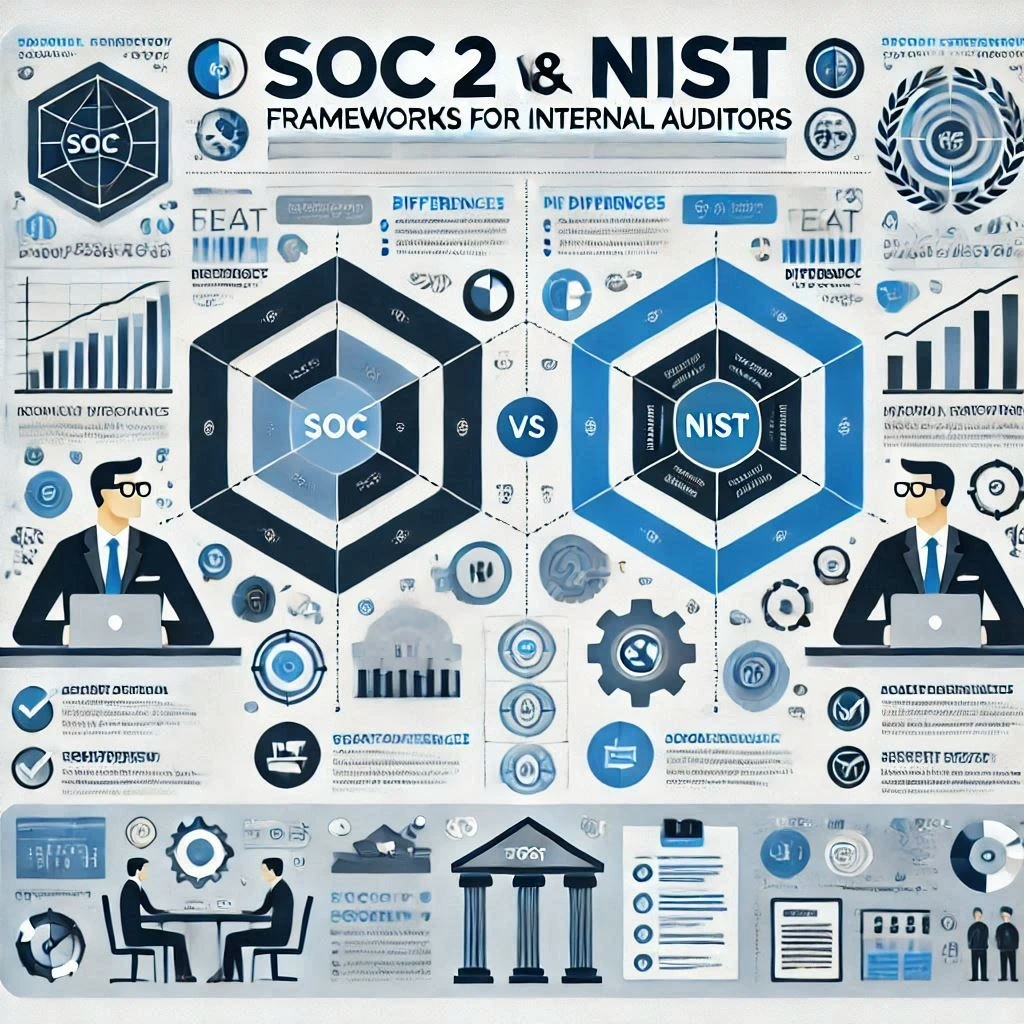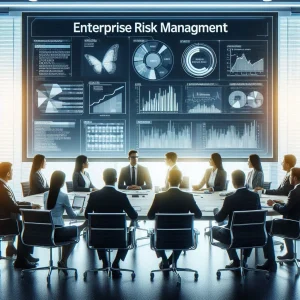Introduction
Two of the most prominent frameworks that internal auditors and compliance officers often encounter are SOC 2 and the NIST Cybersecurity Framework (CSF).
Defining SOC 2 and NIST Frameworks
SOC 2, or System and Organization Controls 2, is an auditing standard developed by the American Institute of Certified Public Accountants (AICPA). It focuses on the security, availability, processing integrity, confidentiality, and privacy of customer data. Organizations that undergo a SOC 2 audit receive independent documentation confirming their compliance, which can be essential for building trust with customers and partners [2][5][12].
On the other hand, the NIST Cybersecurity Framework is a risk management framework established by the National Institute of Standards and Technology (NIST). It provides organizations with a structured approach to managing and reducing cybersecurity risks through a set of guidelines and best practices. Unlike SOC 2, NIST does not offer certification but serves as a comprehensive framework for organizations to assess and improve their cybersecurity posture [6][12].
Importance of Understanding These Frameworks for Internal Auditors
For internal auditors and compliance officers, a thorough understanding of SOC 2 and NIST is vital. Each framework addresses different aspects of security and compliance, and knowing their distinctions can significantly impact an organization’s approach to risk management and data protection. SOC 2 is particularly relevant for service organizations, especially those that handle customer data, while NIST provides a broader risk-based approach applicable to various sectors [10][11].
Purpose of the Blog Post
This blog post aims to provide a comprehensive comparison between SOC 2 and NIST, highlighting their key differences, applications, and implications for internal auditors. By delving into these frameworks, we hope to equip auditors with the knowledge necessary to choose the right framework for their organization’s specific needs and compliance objectives. Understanding these frameworks will not only enhance the effectiveness of internal audits but also contribute to the overall security and integrity of organizational processes [3][4][10].
What is SOC 2?
SOC 2, or System and Organization Controls 2, is a compliance framework established by the American Institute of Certified Public Accountants (AICPA). It is specifically designed for service organizations, particularly those that handle customer data, such as Software as a Service (SaaS) providers. The primary purpose of SOC 2 is to ensure that these organizations manage customer data securely and protect the interests of their clients. This framework emphasizes the importance of data security and privacy, making it a critical standard for organizations that prioritize trust and transparency in their operations [5][8].
Trust Services Criteria (TSC)
SOC 2 is built around five Trust Services Criteria (TSC), which serve as the foundation for evaluating the effectiveness of an organization’s controls related to data management. These criteria are:
- Security: This criterion focuses on the protection of information and systems against unauthorized access. It encompasses measures such as firewalls, intrusion detection systems, and access controls to safeguard sensitive data.
- Availability: This aspect ensures that systems are operational and accessible as needed. Organizations must demonstrate that they have implemented measures to maintain system uptime and recover from disruptions.
- Processing Integrity: This criterion assesses whether the system processing is complete, valid, accurate, and authorized. It ensures that data is processed correctly and that any errors are identified and rectified promptly.
- Confidentiality: This criterion pertains to the protection of sensitive information from unauthorized disclosure. Organizations must have policies and procedures in place to ensure that confidential data is only accessible to authorized individuals.
- Privacy: This aspect focuses on the handling of personal information in accordance with privacy regulations and the organization’s privacy policy. It ensures that personal data is collected, used, retained, and disclosed appropriately [1][9].
Audit Process and Reporting Requirements
The SOC 2 audit process involves an independent third-party auditor evaluating an organization’s controls against the Trust Services Criteria. There are two types of SOC 2 reports:
- Type I Report: This report assesses the design of controls at a specific point in time. It evaluates whether the controls are suitably designed to meet the TSC but does not assess their operational effectiveness.
- Type II Report: This report goes a step further by evaluating the operational effectiveness of the controls over a specified period, typically ranging from six months to a year. It provides a more comprehensive view of how well the organization adheres to the TSC over time [2][10].
The resulting SOC 2 report serves as independent documentation that the organization has achieved compliance with the framework. This report is crucial for building trust with clients and stakeholders, as it demonstrates a commitment to data security and privacy [3][11].
What is NIST?
The National Institute of Standards and Technology (NIST) is a federal agency within the U.S. Department of Commerce that plays a crucial role in developing standards, guidelines, and associated methods and techniques for information security. NIST’s mission is to promote innovation and industrial competitiveness by advancing measurement science, standards, and technology. In the realm of cybersecurity, NIST provides a comprehensive framework that organizations can adopt to manage and mitigate cybersecurity risks effectively.
NIST Cybersecurity Framework (CSF)
The NIST Cybersecurity Framework (CSF) is a voluntary framework that consists of standards, guidelines, and best practices to manage cybersecurity-related risk. It is designed to be flexible and adaptable, allowing organizations of all sizes and sectors to tailor it to their specific needs. The CSF is built around five core functions:
- Identify: This function involves understanding the organization’s environment to manage cybersecurity risk effectively. It includes asset management, risk assessment, and governance.
- Protect: This function focuses on implementing safeguards to ensure the delivery of critical services. It encompasses access control, awareness training, data security, and protective technology.
- Detect: This function aims to develop and implement appropriate activities to identify the occurrence of a cybersecurity event. It includes continuous monitoring and detection processes.
- Respond: This function involves taking action regarding a detected cybersecurity incident. It includes response planning, communications, analysis, and mitigation strategies.
- Recover: This function focuses on maintaining plans for resilience and restoring any capabilities or services that were impaired due to a cybersecurity incident. It includes recovery planning and improvements based on lessons learned.
Risk Management Framework (RMF)
The NIST Risk Management Framework (RMF) is a structured process that integrates security, privacy, and risk management activities into the system development life cycle. It is essential for internal audits as it provides a comprehensive approach to managing risk throughout the organization. The RMF consists of several key steps:
- Categorize: Identify the information system and categorize it based on the impact of a potential security breach.
- Select: Choose appropriate security controls based on the categorization.
- Implement: Apply the selected security controls within the information system.
- Assess: Evaluate the effectiveness of the security controls.
- Authorize: Make a risk-based decision to authorize the operation of the information system.
- Monitor: Continuously monitor the security controls and the system’s security posture.
The RMF is vital for internal auditors as it ensures that organizations not only comply with regulatory requirements but also effectively manage risks associated with their information systems. By understanding and implementing the NIST framework, internal auditors can enhance their organization’s cybersecurity posture and ensure a robust compliance environment.
Key Differences Between SOC 2 and NIST
When internal auditors and compliance officers are tasked with selecting a framework for assessing an organization’s internal controls, understanding the distinctions between SOC 2 and NIST is crucial. Here’s a comprehensive comparison that highlights the primary differences to guide auditors in their decision-making process.
Scope
- SOC 2: This framework is specifically designed for service organizations, particularly those in the technology sector, such as Software as a Service (SaaS) providers. Its primary focus is on the protection of customer data and ensuring that service providers maintain high standards of data security and privacy [1][2].
- NIST: In contrast, the NIST framework, particularly the NIST Cybersecurity Framework (CSF) and NIST SP 800-53, is broader and primarily aimed at federal agencies and organizations that handle Controlled Unclassified Information (CUI). It encompasses a wide range of security controls applicable to various sectors, not limited to service organizations [3][4].
Regulatory Requirements
- SOC 2: Compliance with SOC 2 is often driven by client requirements and industry standards. Organizations that achieve SOC 2 compliance receive an independent audit report that serves as documentation of their adherence to the framework, which can be a significant factor in client trust and business opportunities [2][10].
- NIST: The NIST framework does not provide certification but offers guidelines for compliance. Organizations are expected to implement the framework’s recommendations to manage and reduce cybersecurity risks effectively. This can be particularly important for organizations that must comply with federal regulations or contracts [8][11].
Assessment Criteria
- SOC 2: The assessment criteria for SOC 2 are based on the Trust Services Criteria, which include security, availability, processing integrity, confidentiality, and privacy. These criteria are specifically tailored to evaluate how well a service organization protects customer data and maintains trust [6][11].
- NIST: NIST employs a risk-based approach that focuses on a comprehensive set of security controls. The criteria used in NIST assessments are more extensive and cover a wider range of security practices, making it suitable for organizations with diverse operational needs [5][11].
Reporting
- SOC 2: The reporting format for SOC 2 audits includes detailed reports that outline the auditor’s findings regarding the organization’s internal controls and their effectiveness in meeting the Trust Services Criteria. These reports are typically shared with stakeholders, including clients and partners, to demonstrate compliance and build trust [10][14].
- NIST: NIST does not provide a standardized reporting format like SOC 2. Instead, organizations may develop their own reports based on the implementation of the NIST framework. This can lead to variability in how results are communicated to stakeholders, which may affect transparency and accountability [8][10].
When to Use SOC 2 vs. NIST
Choosing between SOC 2 and NIST frameworks can be pivotal for internal auditors and compliance officers, as each framework serves distinct purposes and is suited for different scenarios. Here’s a comprehensive comparison to guide auditors in selecting the appropriate framework based on specific circumstances.
When SOC 2 is More Beneficial:
- SaaS Companies: SOC 2 is particularly advantageous for Software as a Service (SaaS) companies. It focuses on the security, availability, processing integrity, confidentiality, and privacy of customer data, which are critical for service organizations that handle sensitive information. By obtaining a SOC 2 report, these companies can demonstrate their commitment to data protection and build trust with clients [12][11].
- Client Assurance: Organizations that prioritize client assurance and transparency often benefit from SOC 2 compliance. The audit results provide clients with confidence in the organization’s internal controls and data handling practices, making it a valuable tool for customer retention and acquisition [13][10].
When NIST is More Applicable:
- Government Contracts: NIST is essential for organizations that engage in government contracts, particularly those that handle Controlled Unclassified Information (CUI). Compliance with NIST standards is often a requirement for federal contracts, making it crucial for organizations seeking to work with government entities [9][10].
- Federal Compliance: Organizations operating in sectors that require adherence to federal regulations, such as defense or critical infrastructure, should consider NIST. The NIST Cybersecurity Framework (CSF) provides a risk-based approach to managing cybersecurity risks, which is vital for compliance in these highly regulated environments [10][8].
Considerations for Decision-Making:
- Organizational Size: The size of the organization can influence the choice between SOC 2 and NIST. Smaller organizations may find SOC 2 more manageable due to its focus on specific controls and client assurance, while larger organizations with complex operations may benefit from the comprehensive risk management approach of NIST [4][3].
- Industry: The industry in which the organization operates plays a significant role in determining the appropriate framework. For instance, technology and service-oriented industries may lean towards SOC 2, while sectors like healthcare, finance, and government may necessitate NIST compliance due to regulatory requirements [11][2].
- Risk Tolerance: An organization’s risk tolerance should also be considered. SOC 2 is more focused on trust and security in handling customer data, making it suitable for organizations with a lower risk tolerance. In contrast, NIST’s broader risk management framework may be more appropriate for organizations willing to adopt a more comprehensive approach to cybersecurity risks [10][7].
Best Practices for Internal Auditors
When it comes to internal auditing, understanding the distinctions between SOC 2 and NIST frameworks is crucial for compliance officers and internal auditors. Both frameworks serve to enhance an organization’s cybersecurity posture, but they do so in different ways. Here are some best practices for leveraging these frameworks effectively:
- Recommendations for Conducting Internal Audits:
- Framework Selection: Choose the appropriate framework based on your organization’s specific needs. SOC 2 focuses on the security, availability, processing integrity, confidentiality, and privacy of customer data, making it ideal for service organizations. In contrast, NIST provides a broader risk-based approach that helps organizations manage and reduce cybersecurity risks [3][12].
- Control Assessment: Conduct a thorough assessment of existing controls against the requirements of the selected framework. For SOC 2, this involves evaluating the Trust Services Criteria, while for NIST, it requires reviewing the Control Families outlined in NIST 800-53 [5][9].
- Documentation and Reporting: Ensure that all findings are well-documented. SOC 2 results in an audit report that provides independent verification of compliance, while NIST does not offer certification but provides voluntary guidance [6][12].
- Tips for Aligning Both Frameworks with Organizational Goals:
- Identify Common Controls: Look for overlapping controls between SOC 2 and NIST. This can streamline compliance efforts and ensure that both frameworks are effectively integrated into the organization’s operations [11].
- Risk Management Alignment: Align the objectives of both frameworks with the organization’s risk management strategy. This ensures that cybersecurity measures are not only compliant but also support the overall business goals [4][10].
- Stakeholder Engagement: Involve key stakeholders in the alignment process to ensure that both frameworks meet the needs of various departments within the organization. This collaborative approach can enhance the effectiveness of the internal audit process [4].
- Importance of Continuous Training and Staying Updated on Regulatory Changes:
- Ongoing Education: Internal auditors should engage in continuous training to stay abreast of the latest developments in both SOC 2 and NIST frameworks. This includes understanding updates to regulations and best practices that can impact compliance efforts [10].
- Regular Review of Frameworks: Periodically review both frameworks to ensure that the organization’s practices remain aligned with current standards. This proactive approach can help mitigate risks associated with non-compliance [10][12].
- Networking and Professional Development: Participate in industry forums and professional organizations to share insights and learn from peers about effective auditing practices related to SOC 2 and NIST [10].
By following these best practices, internal auditors can effectively navigate the complexities of SOC 2 and NIST frameworks, ensuring that their organizations not only comply with regulatory requirements but also enhance their overall cybersecurity posture.
Conclusion
Understanding the distinctions between SOC 2 and NIST is crucial for compliance officers and auditors alike. Both frameworks serve vital roles in the landscape of cybersecurity and data protection, yet they cater to different organizational needs and objectives.
- Main Differences and Use Cases: SOC 2 is primarily an auditing standard focused on the security, availability, processing integrity, confidentiality, and privacy of customer data. It is particularly relevant for service organizations that handle sensitive information, providing a framework for evaluating the effectiveness of their controls. In contrast, NIST offers a risk-based approach that assists organizations in managing and mitigating cybersecurity risks. It is more comprehensive and can be applied across various sectors, making it suitable for organizations looking for a structured methodology to identify and address risks effectively [2][7].
- Role of Internal Auditors: Internal auditors play a pivotal role in ensuring compliance with these frameworks. They are responsible for conducting audits, assessing the effectiveness of controls, and ensuring that the organization adheres to the established standards. By understanding both SOC 2 and NIST, auditors can better evaluate their organization’s risk management strategies and compliance posture, ultimately fostering a culture of security and accountability [5][10].
- Assessing Organizational Needs: It is essential for organizations to assess their specific needs when choosing between SOC 2 and NIST. Factors such as business risk tolerance, the nature of the data handled, and regulatory requirements should guide this decision-making process. By aligning the chosen framework with organizational goals, internal auditors can ensure that their compliance efforts are both effective and relevant [6][8].
In summary, a thorough understanding of SOC 2 and NIST not only empowers internal auditors to navigate the complexities of compliance but also enhances the organization’s overall security posture. By making informed decisions based on their unique circumstances, organizations can better protect their data and maintain the trust of their clients.
Find out more about Shaun Stoltz https://www.shaunstoltz.com/about/
This post was written by an AI and reviewed/edited by a human.



